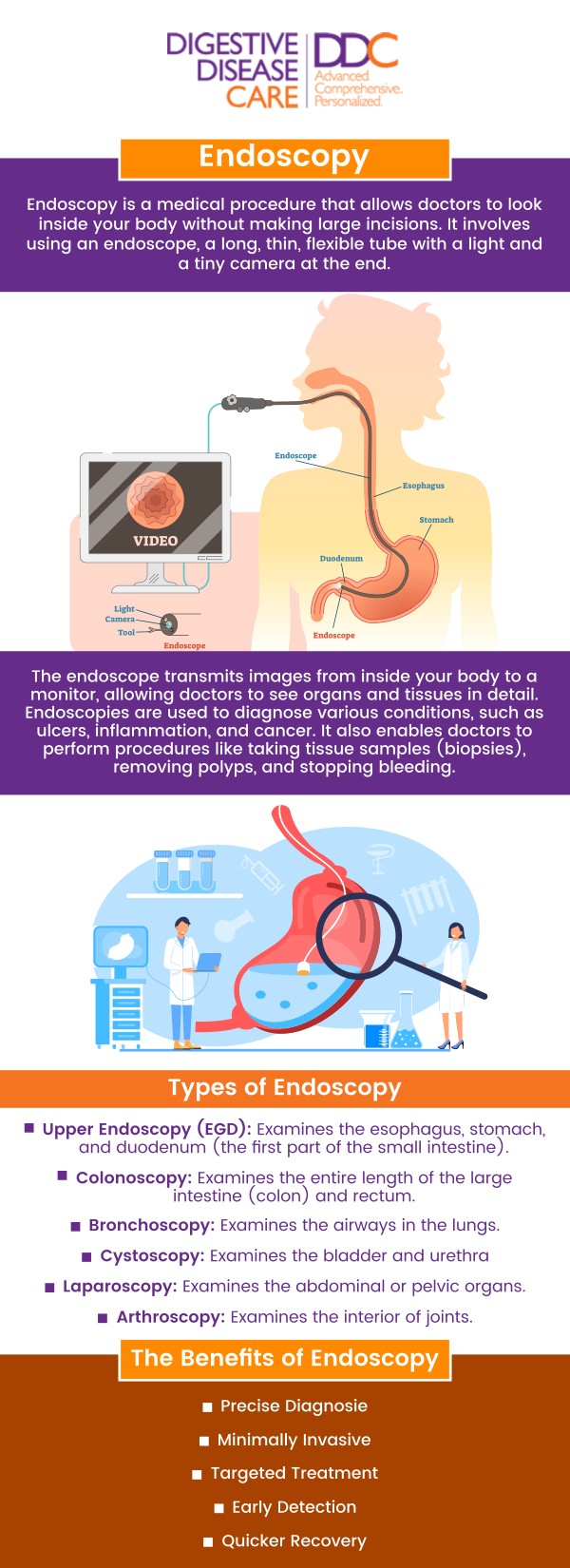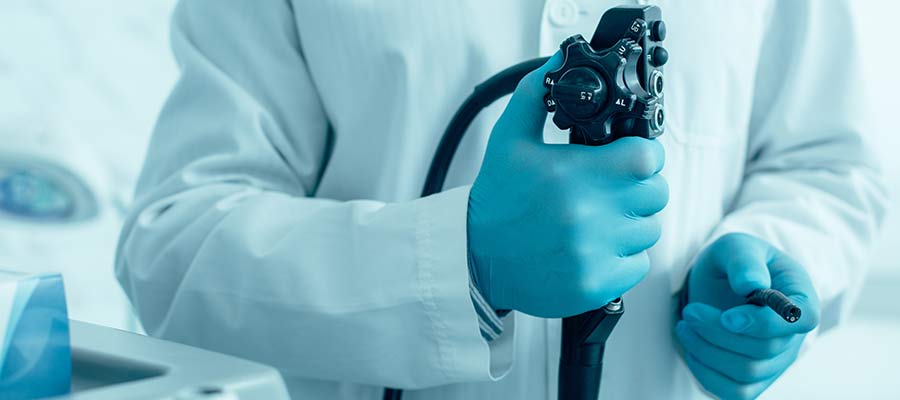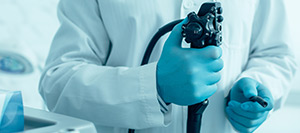Upper Endoscopy (EGD) Procedure Q&A
At Digestive Disease Care (DDC), our board-certified gastroenterologists specialize in Upper Endoscopy (EGD) procedures to diagnose and treat a variety of digestive conditions. With advanced technology, we provide safe, accurate, and personalized care. Trust DDC for expert EGD procedures and comprehensive digestive health management. For more information, contact us or book an appointment online. We have convenient locations to serve you in Babylon NY, East Setauket NY, Forest Hills NY, Jericho NY, Lake Success NY, Melville NY, Mineola NY, Massapequa NY, New Hyde Park NY and Riverhead NY.




Table of Contents:
What is the purpose of an Upper Endoscopy (EGD) procedure?
How long does an Upper Endoscopy (EGD) usually take?
What can I expect after an upper endoscopy?
When should I see a doctor for an upper endoscopy?
At Digestive Disease Care, we understand the importance of a healthy digestive system. That’s why we provide a wide range of services, including Upper Endoscopy, also known as esophagogastroduodenoscopy (EGD).
An EGD is a minimally invasive procedure we employ to diagnose and, in select instances, treat conditions affecting the upper segment of your digestive system, encompassing the esophagus, stomach, and the proximal portion of the small intestine, referred to as the duodenum.
Our experienced gastroenterologists use an EGD to visualize your upper gastrointestinal tract. We deploy a thin, flexible tube equipped with a camera through your mouth and guide it down into your upper digestive tract. The camera transmits real-time images of your esophagus, stomach, and duodenum, allowing us to assess your condition, identify abnormalities, and take biopsies if necessary.
The EGD is crucial in diagnosing various conditions such as gastroesophageal reflux disease (GERD), ulcers, tumors, inflammation in the stomach lining, celiac disease, and hiatal hernia. Beyond diagnosis, the procedure also serves therapeutic purposes. Our doctors can stretch a narrowed area of the esophagus, remove polyps (usually benign growths) or swallowed objects, and treat upper gastrointestinal bleeding using the EGD.
Moreover, an upper endoscopy can serve a significant preventative role. It is instrumental in the early detection of esophageal or stomach cancer. By detecting and removing precancerous growths like certain types of polyps, we can help in preventing the development of these cancers.
The actual EGD procedure typically takes between 15 to 30 minutes, with the duration being subject to individual factors such as the reason for the procedure, your overall health, and the results of the examination. However, this does not account for the preparation time. You will be required to fast for a certain period, usually overnight or for at least six hours before the EGD. Additional time must be allotted for check-in and for the sedative to take effect.
During the procedure, our skilled medical team will insert a thin, flexible tube with a camera on the end through your mouth and into your esophagus. If a biopsy is required or any other therapeutic intervention is performed, this may extend the duration of the procedure.
After the procedure, you will need time to recover from the sedative, which can take anywhere from 30 minutes to an hour. Our medical team may also need to monitor you for any potential complications. In total, from preparation to recovery, you should expect to dedicate about two to three hours for an upper endoscopy procedure.
It’s quite normal to feel groggy after an upper endoscopy due to the sedatives used. Post-procedure symptoms such as bloating, mild nausea, a sore throat, swelling in the back of your mouth, and coughing are temporary and should subside within a few days.
We have a dedicated recovery area where our professional medical staff will monitor you until the sedatives wear off, typically within an hour. Due to the effects of the medication, we advise that you arrange for transportation as you would not be allowed to drive yourself home.
Diet-wise, it is recommended that you abstain from eating and drinking until the numbness in your throat subsides. Usually, patients can resume eating soft, bland foods the next day, but it’s crucial to follow the specific recommendations given by your doctor regarding your diet post-endoscopy.
Pay close attention to any unusual or severe symptoms after your upper endoscopy. Seek immediate medical attention from our team if you experience symptoms such as fever, difficulty swallowing, chest pain, severe or worsening throat, neck, or chest pain, bloody or coffee grounds-like vomit, or severe abdominal pain.
Your doctor will review the results of your upper endoscopy at a follow-up appointment or through a phone call. If biopsies were procured or polyps extirpated, the findings could require several days or weeks to determine. Expect some soreness and swelling in your mouth and throat post-procedure, which should improve gradually over a few days.
Feeling fatigued and drowsy is common but should subside within 24 hours. Most patients recover fully after an upper endoscopy with no long-term complications. However, our team will schedule follow-up appointments as necessary to monitor biopsy results or address any ongoing issues.
An upper endoscopy is a routine diagnostic procedure used by our healthcare professionals to examine the lining of your upper digestive tract, encompassing the esophagus, stomach, and duodenum. This procedure is indispensable for the accurate diagnosis and effective management of disorders affecting these organs.
Reasons to Schedule an Upper Endoscopy:
If you’re experiencing persistent symptoms such as heartburn, nausea, vomiting, bleeding in the digestive tract, difficulty swallowing, or unexplained weight loss, you should seek medical attention.
• Persistent heartburn (GERD): Frequent heartburn or acid reflux symptoms might be a sign of gastroesophageal reflux disease (GERD). Our healthcare providers can perform an endoscopy to determine the severity and underlying causes of your symptoms, such as a hiatus hernia. If over-the-counter treatments for heartburn or GERD prove ineffective, we may recommend an upper endoscopy.
• Difficulty swallowing or esophageal pain: If you’re experiencing discomfort, pain in the esophagus, or dysphagia (difficulty swallowing), it could indicate a narrowing or obstruction in the esophagus. Our endoscopy service can visualize these problems and guide subsequent treatment.
• Unexplained weight loss: Sudden or unexplained weight loss could indicate serious medical conditions, such as certain types of cancer. Our healthcare providers can perform an upper endoscopy to help rule out or diagnose these conditions.
• Upper gastrointestinal bleeding: If you’re noticing blood in your vomit or stools, it can indicate upper gastrointestinal bleeding. An endoscopy allows our healthcare providers to visualize the bleeding site and facilitate intervention.
• Suspected esophageal or stomach cancer: Endoscopy is the primary diagnostic tool for esophageal and gastric cancers. It enables us to take a biopsy and sample tissue to confirm or rule out these malignancies.
Emergency Indications:
You should seek immediate medical attention if:
• Severe abdominal pain: Acute and intense abdominal pain that does not resolve with over-the-counter pain relievers could indicate a life-threatening condition.
• Uncontrollable vomiting or diarrhea: Persistent vomiting or diarrhea can lead to dehydration and electrolyte imbalance, requiring prompt intervention.
Finally, individuals with Barrett’s esophagus, a condition that increases the risk of developing esophageal cancer, should also consider having an upper endoscopy. Schedule your consultation today and embark on a path to better health and well-being. We have convenient locations to serve you in Melville NY, New Hyde Park NY, Forest Hills NY, Jericho NY, Mineola NY, Lake Success NY, Babylon NY, East Setauket NY, Massapequa NY, Riverhead NY and BEYOND.

Check Out Our 5 Star Reviews


Additional Services You May Like

Additional Services You May Like
- Abdominal Pain
- Acid Reflux
- Barretts Esophagus
- Bloating
- Capsule Endoscopy
- Celiac Disease
- Colon Cancer Screening
- Colonoscopy
- Constipation
- Crohns Disease
- Diarrhea
- Diverticulitis
- Esophageal PH Monitoring
- Fatty Liver
- Fibroscan
- Gallstones
- Gastroenterologist
- Gastric Chest Pain
- Gluten Intolerance
- Hemorrhoid
- Hemorrhoid Banding
- Hepatitis
- Irritable Bowel Syndrome
- Lactose Intolerance
- Pancreatitis
- Polyps
- Rectal Bleeding
- Stomach
- Ulcerative Colitis
- GI Urgent Care





